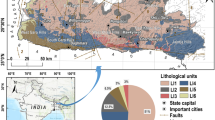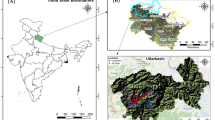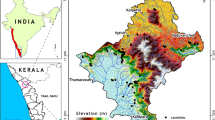Abstract
In this paper, the main objective is to discover an application of a novel classifier based on Composite Hyper-cubes on Iterated Random Projections (CHIRP) for assessment of landslide susceptibility at the Uttarakhand Area (India). For this, 1295 historical landslides events and landslide affecting parameters were collected and used for creating training and testing datasets. Other benchmark models namely Logistic Regression (LR), RBF neural network (ANN-RBF), and Naïve Bayes (NB) were chosen for comparison. Analysis results indicate that the CHIRP is the best, followed by the LR, the ANN-RBF, and the NB, respectively. Overall, the CHIRP indicates as a promising and good alternative method that could be used to assess landslide susceptibility in other landslide prone areas.
Similar content being viewed by others
References
Anand, A., Wilkinson, L., Dang, T.N. (2009) An L-innity norm visual classier. ICDM, pp.687–692.
Ayalew, L., Yamagishi, H. (2005) The application of GIS-based logistic regression for landslide susceptibility mapping in the Kakuda-Yahiko Mountains, Central Japan. Geomorphology, v.65, pp.15–31.
Bai, S.-B., Wang, J., Lü, G.-N., Zhou, P.-G., Hou, S.-S., Xu, S.-N. (2010) GISbased logistic regression for landslide susceptibility mapping of the Zhongxian segment in the Three Gorges area, China. Geomorphology, v.115, pp.23–31.
Chen, W., Xie, X., Peng, J., Wang, J., Duan, Z., Hong, H. (2017a) GIS-based landslide susceptibility modelling: a comparative assessment of kernel logistic regression, Naïve-Bayes tree, and alternating decision tree models. Geomatics, Natural Hazards and Risk, pp.1–24.
Chen, W., Xie, X., Wang, J., Pradhan, B., Hong, H., Bui, D.T., Duan, Z., Ma, J. (2017b) A comparative study of logistic model tree, random forest, and classification and regression tree models for spatial prediction of landslide susceptibility. CATENA, v.151, pp.147–160.
Conforti, M., Pascale, S., Robustelli, G., Sdao, F. (2014) Evaluation of prediction capability of the artificial neural networks for mapping landslide susceptibility in the Turbolo River catchment (northern Calabria, Italy). CATENA, v.113, pp.236–250.
Conoscenti, C., Angileri, S., Cappadonia, C., Rotigliano, E., Agnesi, V., Märker, M. (2014) Gully erosion susceptibility assessment by means of GIS-based logistic regression: A case of Sicily (Italy). Geomorphology, v.204, pp.399–411.
Ercanoglu, M. (2005) Landslide susceptibility assessment of SE Bartin (West Black Sea region, Turkey) by artificial neural networks. Natural Hazards and Earth System Sciences, v.5, pp.979–992.
Hong, H., Liu, J., Zhu, A.-X., Shahabi, H., Pham, B.T., Chen, W., Pradhan, B., Bui, D.T. (2017) A novel hybrid integration model using support vector machines and random subspace for weather-triggered landslide susceptibility assessment in the Wuning area (China). Environ. Earth Sci., v.6, pp.652.
Kanungo, D., Arora, M., Sarkar, S., Gupta, R. (2006) A comparative study of conventional, ANN black box, fuzzy and combined neural and fuzzy weighting procedures for landslide susceptibility zonation in Darjeeling Himalayas. Engg. Geol., v.85, pp.347–366.
Mantovani, F., Soeters, R., Van Westen, C.J. (1996) Remote sensing techniques for landslide studies and hazard zonation in Europe. Geomorphology, v.15, pp.213–225.
Miner, A., Vamplew, P., Windle, D., Flentje, P., Warner, P. (2010) A comparative study of various data mining techniques as applied to the modeling of landslide susceptibility on the Bellarine Peninsula, Victoria, Australia.
NCEP. (2014) Global weather data for SWAT. http://globalweather.tamu.edu/home.
Nefeslioglu, H., Sezer, E., Gokceoglu, C., Bozkir, A., Duman, T. (2010) Assessment of landslide susceptibility by decision trees in the metropolitan area of Istanbul, Turkey. Mathematical Problems in Engineering.
Pham, B.T., Tien Bui, D., Indra, P., Dholakia, M.B. (2015a) Landslide Susceptibility Assessment at a Part of Uttarakhand Himalaya, India using GIS–based Statistical Approach of Frequency Ratio Method. Internat. Jour. Engg. Res. Tech. (IJERT), pp.338–344.
Pham, B.T., Tien Bui, D., Pourghasemi, H.R., Indra, P., Dholakia, M.B. (2015b) Landslide susceptibility assesssment in the Uttarakhand area (India) using GIS: a comparison study of prediction capability of naïve bayes, multilayer perceptron neural networks, and functional trees methods. Theoretical and Applied Climatology, v.22, pp.1–19.
Pham, B.T., Pradhan, B., Tien Bui, D., Prakash, I., Dholakia, M.B. (2016) A comparative study of different machine learning methods for landslide susceptibility assessment: A case study of Uttarakhand area (India). Environmental Modelling & Software, v.84, pp.240–250.
Pham, B.T., Bui, D.T., Prakash, I. (2017a) Landslide Susceptibility Assessment Using Bagging Ensemble Based Alternating Decision Trees, Logistic Regression and J48 Decision Trees Methods: A Comparative Study. Geotechnical and Geological Engineering, pp.1–15.
Pham, B.T., Khosravi, K., Prakash, I. (2017b) Application and Comparison of Decision Tree-Based Machine Learning Methods in Landside Susceptibility Assessment at Pauri Garhwal Area, Uttarakhand, India. Environmental Processes, pp.1–20.
Pham, B.T., Nguyen, V.-T., Ngo, V.-L., Trinh, P.T., Ngo, H.T.T., Bui, D.T. (2017c) A Novel Hybrid Model of Rotation Forest Based Functional Trees for Landslide Susceptibility Mapping: A Case Study at Kon Tum Province, Vietnam, In: Tien Bui D., N.D.A., Bui HB., Hoang ND (Ed.), International Conference on Geo-Spatial Technologies and Earth Resources. Springer, pp.186–201.
Pham, B.T., Prakash, I. (2017d) A Novel Hybrid Intelligent Approach of Random Subspace Ensemble and Reduced Error Pruning Trees for Landslide Susceptibility Modeling: A Case Study at Mu Cang Chai District, Yen Bai Province, Viet Nam, In: Tien Bui D., N.D.A., Bui HB., Hoang ND (Ed.), International Conference on Geo-Spatial Technologies and Earth Resources. Springer, pp.255–269.
Pham, B.T., Prakash, I. (2017e) Spatial Prediction of Rainfall Induced Shallow Landslides Using Adaptive-Network-Based Fuzzy Inference System and Particle Swarm Optimization: A Case Study at the Uttarakhand Area, India, In: Tien Bui D., N.D.A., Bui HB., Hoang ND (Ed.), International Conference on Geo-Spatial Technologies and Earth Resources. Springer, pp.224–238.
Pham, B.T., Prakash, I., Bui, D.T. (2017f) Spatial prediction of landslides using hybrid machine learning approach based on Random Subspace and Classification and Regression Trees. Geomorphology, pp.1–15.
Pham, B.T., Tien Bui, D., Prakash, I., Nguyen, L.H., Dholakia, M.B. (2017g) A comparative study of sequential minimal optimization-based support vector machines, vote feature intervals, and logistic regression in landslide susceptibility assessment using GIS. Environ. Earth Sci., v.76, pp.371.
Poudyal, C.P., Chang, C., Oh, H.-J., Lee, S. (2010) Landslide susceptibility maps comparing frequency ratio and artificial neural networks: a case study from the Nepal Himalaya. Environ. Earth Sci., v.61, pp.1049–1064.
Pourghasemi, H.R., Mohammady, M., Pradhan, B. (2012) Landslide susceptibility mapping using index of entropy and conditional probability models in GIS: Safarood Basin, Iran. CATENA, v.7, pp.71–84.
Rish, I., Hellerstein, J., Jayram, T. (2001) An analysis of data characteristics that affect naive Bayes performance, Technical Report RC21993: IBM T.J. Watson Research Center.
Sarkar, S., Kanungo, D., Mehrotra, G. (1995) Landslide hazard zonation: a case study in Garhwal Himalaya, India. Mountain Research and Development, pp.301–309.
Schuster, R.L. (1996) Socioeconomic significance of landslides. Landslides: Investigation and Mitigation. Washington (DC): National Academy Press. Transportation Research Board Special Report, v.47, pp.12–35.
Segal, R., Kothari, M.L., Madnani, S. (2000) Radial basis function (RBF) network adaptive power system stabilizer. Power Systems, IEEE Transactions, v.15, pp.722–727.
Shirzadi, A., Bui, D.T., Pham, B.T., Solaimani, K., Chapi, K., Kavian, A., Shahabi, H., Revhaug, I. (2017) Shallow landslide susceptibility assessment using a novel hybrid intelligence approach. Environ. Earth Sci., v.76, pp.60.
Stocking, M. (1972) Relief analysis and soil erosion in Rhodesia using multivariate techniques. Zeitschrift fur Geomorphologie NF, v.16, pp.432–443.
Sturges, H.A. (1926) The choice of a class interval. Jour. Amer. Statistical Assoc., v.21, pp.65–66.
Tien Bui, D., Ho, T.-C., Pradhan, B., Pham, B.-T., Nhu, V.-H., Revhaug, I. (2016) GIS-based modeling of rainfall-induced landslides using data mining-based functional trees classifier with AdaBoost, Bagging, and MultiBoost ensemble frameworks. Environ. Earth Sci., v.75, pp.1–22.
Tsytovich, N. (1976) Soil mechanics. Springer. Tu, J.V. (1996) Advantages and disadvantages of using artificial neural networks versus logistic regression for predicting medical outcomes. Jour. Clinical Epidemiology, v.49, pp.1225–1231.
Varnes, D.J. (1984) Landslide hazard zonation: a review of principles and practice, UNESCO Press: Paris, pp.63.
Wilkinson, L., Anand, A., Dang, T.N. (2012) Substantial improvements in the set-covering projection classifier CHIRP (composite hypercubes on iterated random projections). ACM Transactions on Knowledge Discovery from Data (TKDD), v6, pp.19.
Wilkinson, L., Anand, A., Tuan, D.N. (2011) CHIRP: a new classifier based on composite hypercubes on iterated random projections, Proceedings of the 17th ACM SIGKDD international conference on Knowledge discovery and data mining. ACM, pp.6–14.
Yao, X., Tham, L., Dai, F. (2008) Landslide susceptibility mapping based on support vector machine: a case study on natural slopes of Hong Kong, China. Geomorphology, v.101, pp.572–582.
Author information
Authors and Affiliations
Corresponding author
Rights and permissions
About this article
Cite this article
Pham, B.T. A Novel Classifier Based on Composite Hyper-cubes on Iterated Random Projections for Assessment of Landslide Susceptibility. J Geol Soc India 91, 355–362 (2018). https://doi.org/10.1007/s12594-018-0862-5
Received:
Accepted:
Published:
Issue Date:
DOI: https://doi.org/10.1007/s12594-018-0862-5




